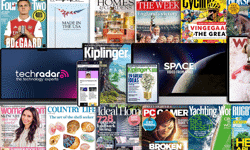It’s hardly news that no media channel (apart from newspapers) has been more heavily impacted by the internet than B2B print publications, and the general trends in US B2B media tend to parallel those in the UK and Western Europe.
Still, InCirculation readers may find some nuggets of interest in a status report on B2Bs on these shores.
At most US B2B companies, print revenue still exceeds digital, and print remains the brand foundation for driving digital and other revenue.
However, ad pages and revenue were flat in 2006 and down by 3.4% and 2%, respectively, in 2007, according to Business Information Network. Thirteen of the 21 categories tracked saw revenue increases last year, but four had gains of under 5%, and many of these saw ad page declines.
As for 2008, even before the unexpectedly precipitous first-quarter decline in the US economy, American Business Media (ABM) was forecasting a print ad revenue decline of 2% to 7%.
Cost-wise, B2Bs and other periodicals got a relative break on the postal front this time (a 2.7% hike to take effect in July). But with paper prices expected to jump by up to 25% this year and print ad revenue looking glum, many companies are cutting title trim sizes, editorial pages and frequencies… for starters.
Reed Elsevier’s decision to put Reed Business Information on the block, coupled with recent cutbacks at other majors, drive home the toll that print economics, in particular, are exacting. The Nielsen Company denies plans to sell Nielsen Business Media (NBM), but it reduced AdWeek’s frequency, and NBM is certainly bearing its share of 4,000 jobs being slashed as part of the parent’s corporate-wide restructuring. Penton Media recently froze salaries and hiring. The new owner of Ziff Davis’s business titles, ZDE, is also cutting jobs.
On the bright side, trade shows saw 10% revenue growth in ’06 and 6.6% growth last year, and ABM projects 7% to 10% gains again this year. (Is it any surprise that Elsevier isn’t selling off Reed Exhibitions?)
As for the internet, ABM forecast that, as in recent years, B2B digital media revenue will grow at a rate of about 20% in 2008 — although that forecast was also made prior to the economy’s Q1 dive.
Needless to say, US B2Bs are continually honing their integrated print / online / event marketing bundles and expanding their online strategies and offerings. In addition to vertical search, supplier / lead generation networks and intensified audience development initiatives to (at last) unify internal databases, promising frontiers include video, social media and online content syndication.
Constant digital development and expansion to stay competitive in the face of rapidly shifting marketer and audience demands do not come cheaply, however. Increasingly, big companies are broadening competencies through acquisitions of various tech entities. But big, medium or small, many B2Bs are caught in a cost crunch that’s stretched resources to near breaking point.
The cost crunch
A cost report done last fall for ABM by Jordan Edmiston Group confirmed that publishing costs are outpacing revenue. Between 2005 and 2006, ad expenses grew 2.5%, ad revenue just 0.4%. Circulation costs rose 9.5%; revenue just 3.3%. Ancillary costs leapt 34% on a 23% revenue gain. Editorial costs rose 6.5%, even as edit pages declined from 44 to 43.
Importantly, these numbers did not reflect ’08 paper / postage hikes, and only partially reflected digital development / maintenance costs.
Yes, overall digital revenue is starting to exceed print revenue, and it’s already exceeded event revenue, according to market research firm Outsell. Outsell estimates total ’07 B2B media revenue at $20 billion, of which digital accounted for 28%, events 27%, and print 45%. By 2009, they estimate that digital will have a 39% share, versus 34% for print and 27% for events. Unfortunately, a preponderance of B2Bs aren’t likely to see digital income exceed their digital costs for years to come.
"It’s all about media fragmentation, determining what your audiences really want, and focusing resources and investment where it counts most. No company can do everything, and it’s a mistake to try," sums up Toni Nevitt, president of eMediaAdvantage, a B2B digital media / audience development consultancy.
Meanwhile, at many companies, even the most diehard pros, across functions, admit privately that the best they can do in the face of continually expanding responsibilities, shrinking resources, re-budgeting and shifting priorities is face each day anew and try to maintain a sense of perspective (and humour). If they had the time, some might be concerned about burn-out.
Not all companies are cutting budgets and staffs, of course. Some are reallocating or even expanding them, albeit mostly in support of digital initiatives. Obviously, CEOs are aware that, despite intense bottom-line pressures, future growth demands finding the wherewithal for greater strategic investment.
Resilient, innovative, experienced employees continue to be B2B’s greatest asset in the struggle to reshape business models. In past recessions, our industry has drained the talent pool, then spent untold sums (not to mention the costs of lost opportunities) in a scramble to restaff and train as economics rebounded. Let’s hope companies keep that in mind in the coming months.
| Key US B2B Media Statistics | |||
| Category | 2007 | 2006 | % +/- |
| Print Ad Revenue | $10.72 billion | $10.94 billion | -2.0% |
| Print Ad Pages | 940,008 | 972,566 | -3.4% |
| Trade Show/Event Revenue | $11.4 billion | $10.7 billion | +6.5% |
| Digital Ad Revenue | - | $8.94 billion | - |
| Sources: Print and event data, Business Information Network and its T-BIN tradeshow service. Digital: Outsell estimate. | |||










